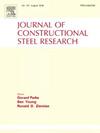Model factor calibration for FEM-based design of slender steel welded plated structures
IF 4
2区 工程技术
Q1 CONSTRUCTION & BUILDING TECHNOLOGY
引用次数: 0
Abstract
FEM-based design is getting widely used in the daily design practice of steel structures. A new Eurocode standard – prEN 1993-1-14 is under preparation to regulate its application. The direct resistance check, where numerical model determines the resistance of the structure needs improvement in terms of handling the uncertainties and ensuring the required safety. The FEM-based design should take into account all the uncertainties handled in traditional analytical calculations and the uncertainties of the numerical model, thus ensuring an equivalent level of safety as required by the Eurocode standards. Therefore, the value of the partial factor associated with the uncertainty of the calculation model should be reassessed and the uncertainty and reliability of the numerical models should be examined. A methodology to evaluate the uncertainties on the resistance side is developed and summarized in this paper, which proposes partial safety factors (γRd, γm, γM and γFE) adapted to the failure probability objectives of the EN 1990 standard. The focus of the study is on a specific failure mode - bending resistance of steel box-section beams - using the results of laboratory experiments. The current paper presents the calculation of the model factor (γFE) for this specific failure mode by using a shell-type numerical model and also compares its application to Monte Carlo simulation-based reliability analysis results to prove the appropriate safety.
求助全文
约1分钟内获得全文
求助全文
来源期刊

Journal of Constructional Steel Research
工程技术-工程:土木
CiteScore
7.90
自引率
19.50%
发文量
550
审稿时长
46 days
期刊介绍:
The Journal of Constructional Steel Research provides an international forum for the presentation and discussion of the latest developments in structural steel research and their applications. It is aimed not only at researchers but also at those likely to be most affected by research results, i.e. designers and fabricators. Original papers of a high standard dealing with all aspects of steel research including theoretical and experimental research on elements, assemblages, connection and material properties are considered for publication.
 求助内容:
求助内容: 应助结果提醒方式:
应助结果提醒方式:


